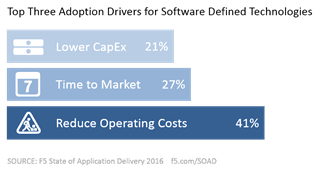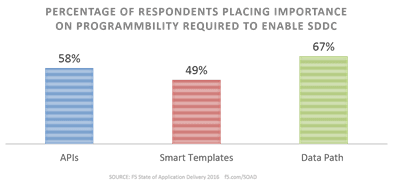
Having watched the ebb and flow of technology trends over the past, well, many years, I’ve come to the conclusion that that the very first thing that drives adoption of new technology is all about costs. When cloud was first introduced, survey after survey told us “cost savings” was the number one reason organizations would adopt it. Today, the primary drivers have shifted from cost to agility and scale.
The software-defined data center (SDDC) - and its cousins SDN and SDX and even DevOps - are currently in the nascent phases of maturity and follow this (now written down) rule: cost savings are the primary driver for adoption. But as our 2016 State of Application Delivery survey shows, where those cost savings come from is not necessarily from the traditional hard costs (physical hardware we call “capex”) but rather from the “soft” costs of operating a data center; the “keep the lights on” overhead we call “opex”.
Closely behind is an emerging “soft cost” previously unknown to most data centers, that of “time to market”. It’s soft, because the cost of failing to get to market in a timely manner can only be estimated in terms of potentially lost revenue, brand awareness, and market share. But these costs are real, and they are intimately tied to the ability of an organization to get to market, quickly, with the apps and services they need to not just maintain business, but encourage growth.
SDDC proposes to address both desires by leveraging technology to automate management and orchestrate provisioning of the app services critical to the successful delivery of apps to their ultimate destination: users, both consumer and corporate.
That technology, of course, is programmability. It’s the APIs and templates that drive the integration as well as the automation necessary to “software-define” the data center. Unsurprisingly, given the top drivers for software-defined technology in our survey, attitudes regarding the importance of these programmatic tools remained high, with nearly 60% indicating that APIs were important, and nearly half tagging smart templates as important.

That’s unsurprising. Programmability is the foundational element upon which technologies like SDDC rely to achieve the efficiency of operations needed to reduce operating expenses and the speed required to improve time to market.
That’s why F5 and VMware continually work to advance the integration between VMware NSX and F5 BIG-IQ Cloud. By enabling operations to automate the provisioning and deployment of the F5 Software Defined Application Services (SDAS) organizations rely on to deliver fast, secure, and available apps, apps can be delivered to the market as quickly and efficiently as possible.
VMware NSX administrators can now provision those app services for a virtual machine without leaving the NSX Manager console. BIG-IQ Cloud integrates with NSX to expose the rich set of F5 application services to both network and virtualization administrators, delivering SDAS and NSX network virtualization from a single administrative standpoint.
That’s achieved via APIs on both sides of the integration that enable the two systems to share information and data important to the fast, efficient provisioning and rapid scale-out of SDAS across the data center. Smart templates that describe SDAS can be exposed to administrators, enabling self-service provisioning that improves the deployment workflow and reduces time to market. The use of templates further promotes standardization of delivery policies that help avoid costly configuration errors as well as decrease repetitive manual steps, ultimately decreasing operational costs.
As noted in our survey, data path programmability is also viewed as an important by the majority (67%) of respondents. 83% of our customers don’t just say that in surveys, they put that into practice using iRules to customize delivery of applications every day. The investment in programmability isn’t something you throw away, whether it’s a critical business app or critical app service. That’s why it’s important to note that we pay careful attention to protecting that investment by enabling F5 iRules and iApps organizations rely on to be maintained and re-used via BIG-IQ Cloud and through this solution, NSX.
App services are pervasive in every organization. They provide for the scale, security, and optimization of the applications – mobile, cloud, legacy, and web – that business increasingly relies on to power success in this application economy. But this digital economy is moving fast, and that means organizations have to most faster and more efficiently. Today that requires faster time to market with leaner deployment pipelines that optimize not only delivery of apps and app services, but budgets, too. By leveraging programmability to integrate solutions, standardize delivery, and automate provisioning and management, you can confidently optimize both VMware NSX with F5 by enabling the SDDC you need to succeed.
For more information on our VMware NSX with F5 solutions:
· VMware NSX with F5 Application Delivery Services
· F5 Reference Architecture for VMware NSX
About the Author

Related Blog Posts

AppViewX + F5: Automating and orchestrating app delivery
As an F5 ADSP Select partner, AppViewX works with F5 to deliver a centralized orchestration solution to manage app services across distributed environments.

Build a quantum-safe backbone for AI with F5 and NetApp
By deploying F5 and NetApp solutions, enterprises can meet the demands of AI workloads, while preparing for a quantum future.

F5 ADSP Partner Program streamlines adoption of F5 platform
The new F5 ADSP Partner Program creates a dynamic ecosystem that drives growth and success for our partners and customers.
F5 NGINX Gateway Fabric is a certified solution for Red Hat OpenShift
F5 collaborates with Red Hat to deliver a solution that combines the high-performance app delivery of F5 NGINX with Red Hat OpenShift’s enterprise Kubernetes capabilities.
F5 Silverline Mitigates Record-Breaking DDoS Attacks
Malicious attacks are increasing in scale and complexity, threatening to overwhelm and breach the internal resources of businesses globally. Often, these attacks combine high-volume traffic with stealthy, low-and-slow, application-targeted attack techniques, powered by either automated botnets or human-driven tools.
Phishing Attacks Soar 220% During COVID-19 Peak as Cybercriminal Opportunism Intensifies
David Warburton, author of the F5 Labs 2020 Phishing and Fraud Report, describes how fraudsters are adapting to the pandemic and maps out the trends ahead in this video, with summary comments.
